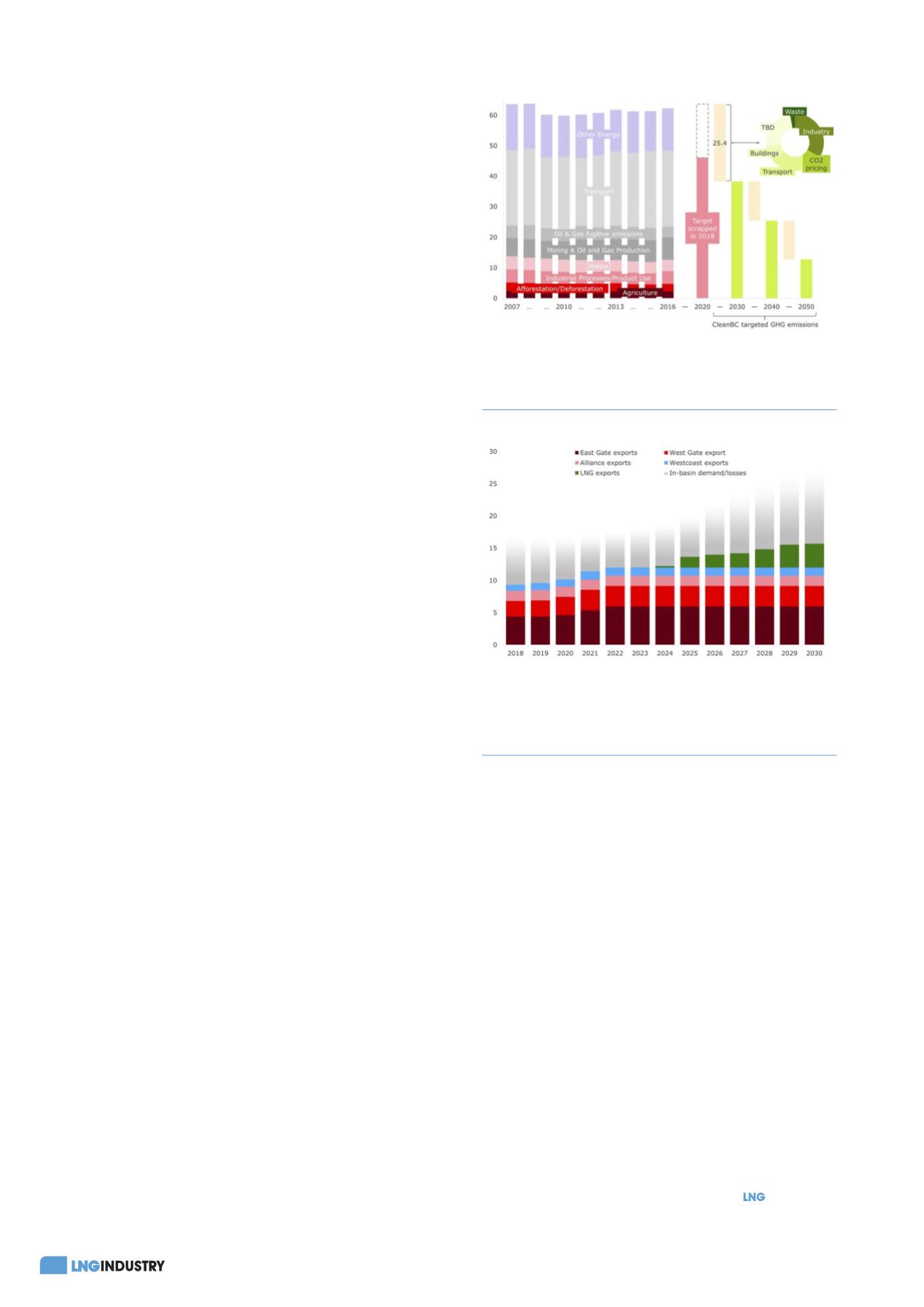
14
April 2020
emissions from LNG plants at 0.16 million tCO
2
e, meaning
that new LNG developments of any size would effectively be
required to utilise electric drive technology to comply with
provincial standards. Electric drive, in turn, would have the
benefit of powering the liquefaction process through B.C.’s
abundant hydroelectric resources as opposed to
higher-emitting natural gas turbines.
Although CleanBC was followed by the cancellation of
ExxonMobil’s Westcoast Canada project (December 2018) and
Steelhead LNG’s Kwispaa scheme (February 2019), at least one
major project sought to reconcile its emissions profile with
B.C.’s revised targets.
In April 2019, Chevron submitted an amended
application to the Canada Energy Regulator (CER) for the
Kitimat LNG project, a 50/50 joint venture with Woodside
Energy. Originally consisting of two gas-powered liquefaction
trains with total capacity of 10 million tpy and a 20-year
export licence, the revised application envisioned the
project’s expansion to three trains with capacity of
18 million tpy and a 40-year export licence. Most crucially,
Chevron committed to powering the facility with electric
drive as opposed to feed gas, thus reconciling Kitimat with
CleanBC. In December 2019, federal regulators approved the
reconceptualised project.
LNG Canada also saw a reduction in its emissions profile
and something of a policy carrot. In summer 2019, the
federal government provided the project with
CAN$220 million in funding for more energy-efficient gas
turbines, which aim to lower fuel use in the liquefaction
process and thus reduce the emissions profile of Trains 1 – 2.
The investment builds on an emissions profile that is already
comparatively low in terms of global LNG projects. In any
case, 80% of LNG Canada’s power needs were slated to come
from natural gas feedstock, with the remaining 20% being
sourced from hydroelectric utility BC Hydro.
Woodfibre LNG had already committed to electric drive
following community consultations in Squamish in 2014.
Woodfibre likewise received regulatory support in
August 2019, when the federal government exempted the
project from fabricated steel duties that the
Canadian International Trade Tribunal had previously
imposed in 2017. As such, one of the final barriers to a
positive FID was removed and Woodfibre ordered a major
piece of project equipment. A positive FID, however, was
punted further into 2020 due to last-minute amendments to
its worker accommodation plans. Given the duties exemption
and Pacific’s successful acquisition of Canbriam Energy,
however, Rystad Energy expects a positive FID for Woodfibre
at some point in 2020.
Local solutions to Canada’s LNG
challenge
Regulatory approval for the Kitimat amendments
notwithstanding, Chevron put its 50% stake in the project
up for sale in late 2019 following a review of its long-term
natural gas price outlook. The supermajor recorded an
impairment of approximately US$10.4 billion in 4Q19,
driven by its share in Kitimat, as well as upstream shale
gas projects in the Appalachian basin. Similarly, in February
2020, Woodside recorded a AUS$720 million impairment
of its Kitimat asset, which includes both its stake in the
LNG export terminal as well as upstream assets in the
Liard Basin.
Recent experience with Kitimat has been bittersweet,
perhaps. While its conceptual retooling demonstrated the
global competitiveness of lower-emissions LNG projects,
Chevron’s announcement likewise underscored the continued
vulnerability of Canada’s LNG industry to the vagaries of
portfolio optimisation, particularly when major foreign
players with diversified portfolios are involved.
Looking forward, the experience of Rockies LNG may
prove most salient for Canada’s LNG future. While LNG
Canada and Woodfibre – that is, projects with the highest
chance of success at this point – will no doubt be a boon to
the industry, large scale future developments may ultimately
hinge on the collective efforts of local upstream players
with more skin in the game. To be sure, the WCSB’s natural
gas potential is enormous, bolstered by large reserves of
liquids-rich gas with favourable economics. While western
Canada’s upstream industry will of course benefit from
greater connectedness to markets in eastern Canada and the
US in coming years, as well as modest increases in in-basin
demand, market diversification away from North America
will no doubt prove crucial in the long-term.
Figure 3.
British Columbia (B.C.) historical
greenhouse gas (GHG) emissions by industry and future
targets (million tCO
2
e/yr). Source: Province of B.C.
Figure 4.
WCSB natural gas production by offtake/demand
source (billion ft3/d). Source: Rystad Energy GasMarketCube;
Canada Energy Regulator; company reporting.








